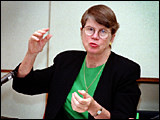THE DREAMS OF JANET RENO
Social Services as Crime-Fighting Tools
November 23, 1998
By Hoag Levins

|
|
Photo: Hoag Levins
Janet Reno speaks of children and violent crimes.
|
|
WASHINGTON, D.C. (APBnews.com) -- A soliloquy that U.S. Attorney General Janet Reno delivered during a press conference of Criminal Justice Journalists (CJJ) ten days ago adds an extra dimension to her latest comments about the FBI Uniform Crime Report (UCR) released on Sunday.
In issuing an advance interpretation of that data on Friday, Reno noted that among the UCR's most important statistics were those documenting that the number of violent crimes committed by children is down for the third year in a row. She suggested the decline was the result of the encouragement and support her department has given to local communities that make social services a major component of their crime-fighting strategies.
Stopping criminals before they happen
Back on Nov. 13, during a meeting at the Justice Department with members of the national CJJ organization, Reno broke from her standard press-conference answers to speak spontaneously and at length about the same topic -- the connections she sees between crime and a culture that fails to adequately nurture many of its children.
A former state attorney in Miami, Fla., and currently the country's top law enforcement officer, Reno explained why she felt her department had to be as concerned about building families as it was about busting crime. In part, she said:
"What I would really like to see in terms of [the fight against] violent crime is every community in America organized with the building blocks necessary to create strong and healthy families and strong and healthy children.
Visions from a crack epidemic
"I'm influenced by the fact that when the crack epidemic hit Miami in 1985, the doctors took me to the public hospital to try to figure out what to do about crack-involved infants and their mothers. Did we prosecute them? Did we seek dependence adjudications? What did we do?
"The doctors then taught me that the first three years of life were the most formative; that's when the child learned the concept of reward and punishment and developed a conscience. And I said to myself, 'What good are the prisons going to be 18 years from now if the child doesn't understand what punishment means and it doesn't have a conscience?'
"Here are the building blocks that I have seen and I'm trying to pull them together [through Justice Department programs]: A focus on domestic violence because the child who sees their parents beat each other comes to accept violence as a way of life, health care because preventative health care for children in America is essential, educare in the zero-through-three and zero-through-five [age range] through Headstart programs, good strong constructive child care that's more than warehousing children, and non-school-hour supervision because children are more at risk and alone than at any time in our history.
"Another building block is education itself, whether it be in those early years or in what we do to enhance teaching by reducing class size and improving the circumstances in which teachers can teach.
'I have a dream'
"There are so many [other services we should be providing for children], but then I have a dream. I am watching more and more lawyers learn how to negotiate or settle cases through appropriate dispute resolution; cases that were never settled before. And I have seen teachers at some 15 public schools in the D.C. area learning how to teach conflict resolution to children in the schools and I see it working.
"I see police officers at some of these programs. I have a dream that everybody graduating from a school of education with a teaching certificate will have coursework in how to teach kids how to resolve conflicts without knives and guns and fists and how to solve problems without knives and guns and fists. I have a dream that we will teach every police officer in basic law enforcement academies the same skills.
Changing a culture of violence
"I am convinced that if we focus on the illegal possession and use of guns, if we focus on conflict resolution, if we give kids sufficient building blocks to make a go of it, we can change the culture of violence in this country. We can never eliminate it but we can change it."
Hoag Levins is the managing editor of APBnews.com.
© 1998 APBnews.com
.
| 
